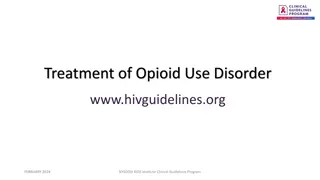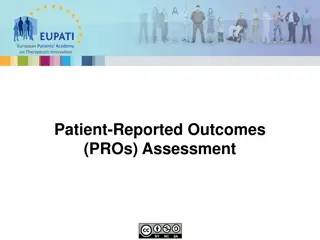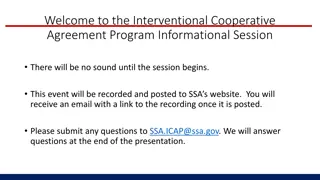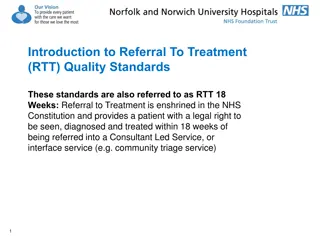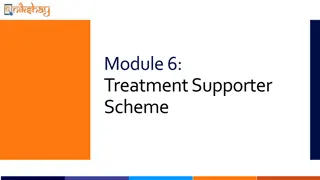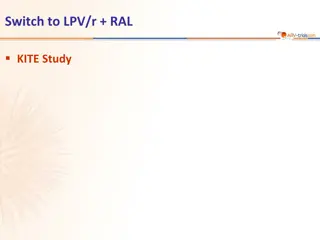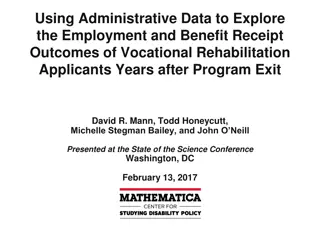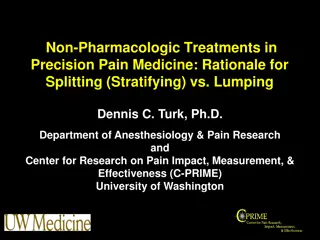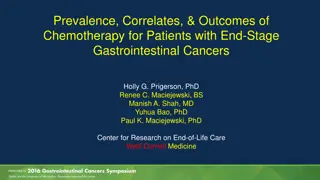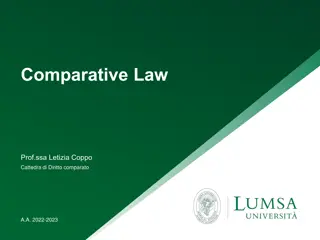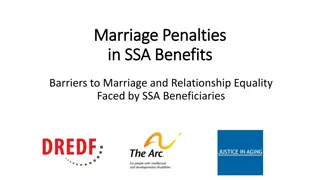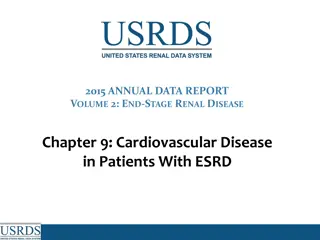Clinical Outcomes of SSA Treatment in Patients with DIPNECH: Key Findings
A summary of a study presented at the ENETS 2020 Virtual Meeting on the use of somatostatin analogs (SSA) in treating Diffuse Idiopathic Pulmonary Neuroendocrine Cell Hyperplasia (DIPNECH). The study focused on patient characteristics, symptom improvement, and FEV1 test results. Key results include details on symptom changes and patient demographics.
Uploaded on Apr 19, 2025 | 0 Views
Download Presentation

Please find below an Image/Link to download the presentation.
The content on the website is provided AS IS for your information and personal use only. It may not be sold, licensed, or shared on other websites without obtaining consent from the author.If you encounter any issues during the download, it is possible that the publisher has removed the file from their server.
You are allowed to download the files provided on this website for personal or commercial use, subject to the condition that they are used lawfully. All files are the property of their respective owners.
The content on the website is provided AS IS for your information and personal use only. It may not be sold, licensed, or shared on other websites without obtaining consent from the author.
E N D
Presentation Transcript
MEETING SUMMARY ENETS 2020 VIRTUAL MEETING Dr Alia Munir MBBCH MRCP PhD FRCP Consultant Endocrinologist Sheffield Teaching Hospitals NHS Foundation Trust, UK March 2020 2
DISCLAIMER AND DISCLOSURES NET CONNECT is supported by an Independent Educational Grant from Ipsen The views expressed within this presentation are the personal opinion of the author. They do not necessarily represent the views of the author s academic institution or the rest of the NET CONNECT group DISCLOSURES DR. MUNIR Speaker fees AAA and Novartis Joint working partnership Novartis Ipsen 3
PRESIDENTIAL ABSTRACT CLINICAL SCIENCE: SOMATOSTATIN ANALOGS (SSA) IN PATIENTS WITH SYMPTOMATIC DIFFUSE IDIOPATHIC PULMONARY NEUROENDOCRINE CELL HYPERPLASIA (DIPNECH) Al-Toubah T, et al. ENETS 2020. Abstract #H01 4
BACKGROUND DIPNECH is a very rare lung disorder considered a precursor of tumourlets and typical/atypical carcinoids1 A typical patient is a middle aged non-smoking woman presenting with decades of chronic cough and dyspnoea Radiological signs include: Multifocal pulmonary nodules Mosaic attenuation with air trapping Ground glass appearance Endobronchial wall thickening Atelectasis This multi-institution retrospective chart review on outcomes of SSA treatment in DIPNECH DIPNECH, diffuse idiopathic pulmonary neuroendocrine cell hyperplasia; SSA, somatostatin analogues 1. Brambilla B, et al. Eur Respir J 2001;18:1059-68; 2. Gorshtein A, et al. Cancer 2012;118:612-9; 3. Chauhan A and Ramirez RA. Lung 2015;193:653-7 ; 4. Al-Toubah T, et al. ENETS 2020. Abstract #H01 (Oral presentation) 5
KEY RESULTS PATIENT CHARACTERISTICS SYMPTOM IMPROVEMENT 20 N (%) Sex Female Male Age <50 50-59 60-69 70+ Ki-67% (on biopsy or surgical specimen) Not reported 2% 3-20% Smoking history Yes No Other therapies for respiratory symptoms 0 1 2-3 >3 Baseline symptoms Cough Dyspnea Fatigue Wheezing Palpitations Chest tightness Hot flashes Hirsutism Abdominal pain 40 (95.2) 2 (4.8) 15 15 10 4 (9.6) 13 (30.9) 10 (23.8) 15 (35.7) 11 10 5 6 0 25 (59.5) 16 (38.1) 1 (2.4) Mild Moderate Significant None CHANGE IN FEV1 TEST RESULTSa 10 (23.8) 32 (76.2) 100 11 (26.2) 9 (21.4) 18 (42.9) 4 (9.5) 80 Patients (%) 60 40 34 (80.9) 27 (64.2) 6 (14.3) 5 (11.9) 4 (9.5) 2 (4.7) 1 (2.4) 1 (2.4) 1. (2.4) 20 0 Value change Category change Improved No change Worse a15 patients had pre and post treatment FEV1 data DIPNECH, diffuse idiopathic pulmonary neuroendocrine cell hyperplasia; FEV1, forced expiratory volume in 1 second; SSA, somatostatin analogues. Al-Toubah T, et al. ENETS 2020. Abstract #H01 (Oral presentation) 6
CONCLUSION This was the largest cohort study of SSA therapy for DIPNECH SSA therapy was effective at palliating symptoms 76% had a degree of improvement 26% reported significant improvement 13 of 15 (87%) showed an improvement in PFTs The mechanism of SSA remains uncertain Inhibit PNEC autocrine/paracrine secretion Diminished airway reactivity Malignant/metastatic transformation of DIPNECH is rare SSA should be considered standard of care in DIPNECH patients Further work to investigate aetiology and larger clinical studies are needed DIPNECH, diffuse idiopathic pulmonary neuroendocrine cell hyperplasia; PFT, pulmonary-function test; PNEC, pulmonary neuroendocrine cell; SSA, somatostatin analogue Al-Toubah T, et al. ENETS 2020. Abstract #H01 (Oral presentation) 7
177Lu-DOTATATE PLUS 166Ho- RADIOEMBOLIZATION IN PATIENTS WITH NEUROENDOCRINE TUMOURS; A SINGLE CENTER, PROSPECTIVE, INTERVENTIONAL, NON- COMPARATIVE, OPEN LABEL, PHASE II STUDY (HEPAR PLuS STUDY) Braat A, et al. ENETS 2020. Abstract #K04 8
BACKGROUND Liver disease in NENs is a major factor which impacts survival1 BULKY LIVER METASTASES (>30 mm) DECREASES SURVIVAL2 Treatment options include1: Surgical resection TAE PRRT 100 % of subject's progression-free 90 80 177Lu-DOTATATE arm 0 vs 1 large lesion: Log-rank P value 0.0037 70 60 50 40 In general clinical practice PRRT outcomes are good but could be better1 30 20 10 Octreotide LAR 60 mg arm 0 vs 1 large lesion: Log-rank P value 0.3398 0 0 3 6 9 12 15 Months 18 21 24 27 30 33 HEPAR PLuS is the first prospective single arm phase II trial of combination 177Lu-DOTATATE PRRT and 166Ho-radioembolization in NEN Treatment Octreotide LAR 60 mg Presence of large lesion at baseline No large lesion 1 large lesion 177Lu-DOTATATE + octreotide LAR 30 mg 166Ho, holmium-166; LAR, long-acting release; 177Lu, lutenium-177; NEN, neuroendocrine neoplasm; PRRT, peptide receptor radionuclide therapy; TAE, trans-arterial embolisation Braat A, et al. BMC Gastroenterol 2018;18:84; 2. Strosberg J, et al. Annals of Oncology (2018) 29 (suppl_8): viii467-viii478; 3.Strosberg J, et al. EurJ Nucl Med Mol Imaging 2018; 45 (suppl 1): OP-180 Braat A, et al. ENETS 2020. Abstract #K04, Oral Presentation 9
STUDY ENROLMENT AND KEY DISEASE CHARACTERISTICS PATIENT DISPOSITION TUMOUR CHARACTERISTICS N (%) Primary tumour Pancreas Ileum or jejunum Unknown Colon, caecum, or rectum Bronchus or lung Functioning neuroendocrine neoplasms Neuroendocrine neoplasm grade 1 2 Fractional liver involvement <25% 25 to 50% >50 to 70% Extrahepatic disease Yes No 34 patients screened 9 (30) 9 (30) 5 (17) 4 (13) 3 (10) 9 (30) 3 excluded 1 <3 RECIST 1.1 measurable liver metastases on screening CT 2 passed inclusion period of 20 weeks after 177Lu-dotatate 31 received 166Ho-radioembolisation 12 (40) 18 (60) 1 excluded 1 died before CT at 3 months 22 (73) 6 (20) 2 (7) 30 included in per-protocol analysis 24 (80) 6 (20) CT, computed tomography; 166Ho, holmium-166; RECIST, response evaluation criteria in solid tumours Braat A, et al. Lancet Oncol 2020; DOI: https://doi.org/10.1016/S1470-2045(20)30027-9 Braat A, et al. ENETS 2020. Abstract #K04, Oral Presentation 10
PRIMARY EFFICACY ENDPOINT PRIMARY EFFICACY OUTCOMES 3 months Liver-specific response RECIST 1.1 (n=30) Complete response 0 Partial response 13 (43%) Stable disease 15 (50%) Progressive disease 2 (7%) NA 0 mRECIST (n=30) Complete response 3 (10%) Partial response 15 (50%) Progressive disease 0 NA 4 (13%) Efficacy outcomes 6 months Liver-specific response Patient-based response Patient-based response Additional durable CR/PR after PRRT (mRECIST) 0 12 (40%) 14 (47%) 4 (13%) 0 0 14 (47%) 11 (37%) 4 (13%) 1 (3%) 0 10 (33%) 13 (43%) 6 (20%) 1 (3%) Clinical toxicity Similar to radioembolisation of other tumour types in salvage setting 2 (7%) 15 (50%) 1 (3%) 5 (17%) Biochemical toxicity PRIMARY SAFETY OUTCOMES Grade 1 2 Related toxicity Radioembolisation- induced liver disease Abdominal pain 21 (68%) Fatigue 18 (58%) Nausea 19 (61%) Vomiting 13 (42%) Malaise 8 (25%) Subfebrile 4 (13%) Shivering 3 (10%) Oedema 2 (6%) Grade 3 Grade 4 Grade 5 Peak in liver enzymes at 3 weeks 0 0 0 1 (3%) QoL reductions peaked at 3-6 weeks 3 (10%) 1 (3%) 1 (3%) 0 0 0 0 0 0 0 0 0 0 0 0 0 0 0 0 0 0 0 0 0 Peak in fatigue at 3 weeks Resolution at 3 months CR, complete response; NA, not applicable; PR, partial response; QoL, quality of life; RECIST, response evaluation criteria in solid tumours; mRECIST, modified RECIST Braat A, et al. Lancet Oncol 2020; DOI: https://doi.org/10.1016/S1470-2045(20)30027-9; Braat A, et al. ENETS 2020. Abstract #K04, Oral Presentation 11
CONCLUSIONS SO FAR.. Additional 166Ho-radioembolization Effective in bulky liver disease after PRRT Is safe and effective after PRRT1 Toxicity profile comparable to literature2 QoL was temporarily decreased and fully recovered at 3 months OS and PFS have not been reached, long term follow up is needed Dosimetric analysis results are very exciting 166Ho, holmium-166; OS, overall survival; PFS, progression-free survival; PRRT, peptide receptor radionuclide therapy; QoL, quality of life 1. Braat A, et al. Lancet Oncol 2020; DOI: https://doi.org/10.1016/S1470-2045(20)30027-9; 2. Braat A and Lam M. Cardiovasc Intervent Radiol 2019; 41:200-1; Braat A, et al. ENETS 2020. Abstract #K04, Oral Presentation 12
ASSESSING RESPONSE TO PRRT Prasad V, et al. ENETS 2020 13
RESPONSE ASSESSMENT Assesses the efficacy of drugs in clinical trials in order to avoid or reduce Cost of drug development Unnecessary public health risk by early identification of drug failure and reduction of biases and statistical errors In NETs, the Gold Standard is pre- and post-therapy tumour tissue sampling Response assessment criteria vary by cancer type Both clinical endpoints and surrogate biomarkers can be used to assess response Biomarker endpoints Measured objectivelyy Surrogate for clinical endpoints Clinical endpoints Variables of subjects health and well-being Valuable to assess OS and QoL NET, neuroendocrine tumour; OS, overall survival; QoL, quality of life 1. Faraji F and Gaba RC. Front Oncol 2019;4;9:471; 2. DiMasi JA, et al. J Health Econ 2016;47:20-33; Prasad V. ENETS 2020, Oral Presentation 14
RESPONSE ASSESSMENT IN NEUROENDOCRINE TUMOURS REDUCED TUMOUR SIZE AS AN OUTCOME Reduction in tumour size can act as an objective response measure1 KAPLAN-MEIER CURVE OF PFS IN RELATION TO TUMOUR RESPONSE 100 At least 30% decrease Decrease <30% 80 probability Censored Survival 60 40 20 0 0 8 10 4 30 20 2 4 30 1 1 40 1 0 50 0 0 At least 30% decrease Decrease <30% 106 CgA, chromogranin A; MR; minor response; NET, neuroendocrine tumour; PD, disease progression; PR, partial response; PRRT, peptide receptor radionuclide therapy; SD, stable disease 1. Pavel M, et al. Ann Oncol 2019;30(Supp. 5):v564-73; Prasad V. ENETS 2020, Oral Presentation 15
RESPONSE ASSESSMENT IN NEUROENDOCRINE TUMOURS RADIOLOGY AND PSEUDO-PROGRESSION Progression markers like CgA may be caused by radiology-induced cell damage2 Liver function parameters and CgA should be interpreted with caution Transient increase in metastasis size ( 10%) may occur post-PRRT True progression is almost always reflected by new metastases TRANSIENT INCREASE IN CgA POST-THERAPY PR MR SD PD 300 Difference from baseline % 200 100 0 CgA, chromogranin A; MR; minor response; NET, neuroendocrine tumour; PD, disease progression; PR, partial response; PRRT, peptide receptor radionuclide therapy; SD, stable disease Brabander T, et al. Endocr Relat Cancer 2017;24:243-51; Prasad V. ENETS 2020, Oral Presentation 16
ROAD MAP TO NEW RESPONSE IN PEPTIDE RECEPTOR RADIONUCLIDE THERAPY Definitions: cystic, new lesion, pseudo- progression Consider tumour heterogeneity in selection of target lesions Inclusion of diffusion MRI and biomarkers Basic platform RECIST 1.1 QoL and toxicity accounted for Consider tumour burden in selection of target lesions in the liver Verification of cut-off values through data analysis PET scan for ambiguous lesions Inclusion of PD MRI, magnetic resonance imaging; PD, disease progression; PET, positron emission tomography; PRRT, peptide receptor radionuclide therapy; QoL, quality of life; RECIST, Response evaluation criteria in solid tumours 17
CONCLUSION Optimal criteria for the response of PRRT is a challenge Process requires a collective effort collect to prospectively study and real world data to find the best response criteria for PRRT PET must be included in the response assessment of PRRT PET, positron emission tomography; PRRT, peptide receptor radionuclide therapy Prasad V. ENETS 2020, Oral Presentation 18
REACH NET CONNECT VIA TWITTER, LINKEDIN, VIMEO & EMAIL OR VISIT THE GROUP S WEBSITE http://www.net-connect.info Follow the NET CONNECT group on LinkedIn Watch us on the Vimeo Channel NET CONNECT Email Follow us on Twitter @net-connectinfo antoine.lacombe @cor2ed.com 19
NET CONNECT Bodenackerstrasse 17 4103 Bottmingen SWITZERLAND Dr. Antoine Lacombe Pharm D, MBA Phone: +41 79 529 42 79 antoine.lacombe@cor2ed.com Dr. Froukje Sosef MD Phone: +31 6 2324 3636 froukje.sosef@cor2ed.com


